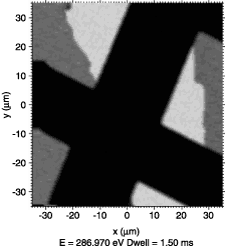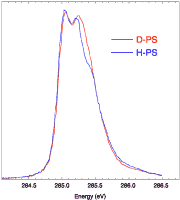
Vibronic Features in Polymer NEXAFS
Researchers conducting polymer analyses with the Scanning Transmission X-Ray Microscope (STXM) on Beamline 7.0.1 have observed a phenomenon not previously considered relevant to the spectra of polymers. Their work has shown that vibronic effects--the combination of electronic and vibrational changes--have a significant effect on the near-edge x-ray absorption fine structure (NEXAFS) spectra of polystyrene. The observation of vibronic features in this polymer suggests that the phenomenon affects spectra of other large, complex molecules. This information will be crucial in interpreting future spectra as finer resolutions make smaller spectral features observable.
|
The group from North Carolina State University and the State University of New York, Stony Brook, came to the ALS after preliminary work at the National Synchrotron Light Source's Beamline X1A. The ALS STXM offered a high photon flux with a resolving power of 5700, enabling them to study subtle differences in the fine structures of polystyrene spectra. In order to isolate the vibronic effect from the chemical shifts known to affect the shapes of NEXAFS peaks, they collected spectra from regular protonated polystyrene (H-PS) and polystyrene in which the hydrogen atoms were replaced by deuterium (D-PS). In D-PS, the deuterium atoms that replace the hydrogen atoms differ from the hydrogen atoms in mass only. The mass difference leads to a dramatic change in the C-H stretch energies without introducing a difference in chemical state. These stretches translate to vibronic features in the NEXAFS spectra. Thus, any real differences between the spectra for H-PS and D-PS could be attributed to vibronic effects. A clever sample setup
took advantage of STXM's spatial resolution to provide a control
for the inevitable differences between sets of data taken in separate
sessions. The scientists mounted two samples, one of H-PS and one
of D-PS, on the same sample mount less than one micron apart. They
then captured a series of x-ray transmission images of the samples,
scanning across a typical range of energies. From this they could
measure x-ray transmission and incident photon flux (needed to normalize
the data) for both samples at each energy in the scan. By taking
the data for both samples concurrently, they minimized low-frequency
noise, mechanical drift, and electron beam decay factors and exactly
matched the relative energy scales for the two samples. 
|
Molecular Wiggles Merit Attention
|
|
The resulting carbon 1s spectra for H-PS and D-PS clearly differed. Moreover, the differences between them corresponded well to the vibronic shift seen in previous studies of benzene, which consists of a ring structure that is analogous to that in the repeating unit of polystyrene. Correlations were also seen with vibronic effects in calculated spectra for toluene (an even closer analog to polystyrene's repeating structure). This, together with the much wider peak width seen for the polystyrene spectrum than predicted by chemical shift alone, suggests that vibronic effects have a notable effect on the C 1s --> 1p* transition in all aromatic polymers.

This study is the first to report vibronic effects in the carbon 1s NEXAFS spectrum of a high-molecular-weight polymer. Though current theories of polymer spectroscopy hold that only changes in chemical state are relevant to the spectra of such large molecules, this work has shown clearly that vibronic effects must be considered in these analyses. Research conducted by S.G. Urquhart and H. Ade (North Carolina State University) and M. Rafailovich, J.S. Sokolov, and Y. Zhang (State University of New York, Stony Brook). Research funding: Office of Basic Energy Sciences (BES) and Office of Biological and Environmental Research, U.S. Department of Energy; National Science Foundation. Operation of the ALS is supported by BES. Publication about this research: S.G. Urquhart, H.Ade, M. Rafailovich, J.S. Sokolov, and Y. Zhang, "Chemical and vibronic effects in the high-resolution near-edge x-ray absorption fine structure spectra of polystyrene isotopomers," Chem. Phys. Lett. 322, 412 (2000).
ALSNews Vol. 168, January 17, 2001 |
||
More ALS Science